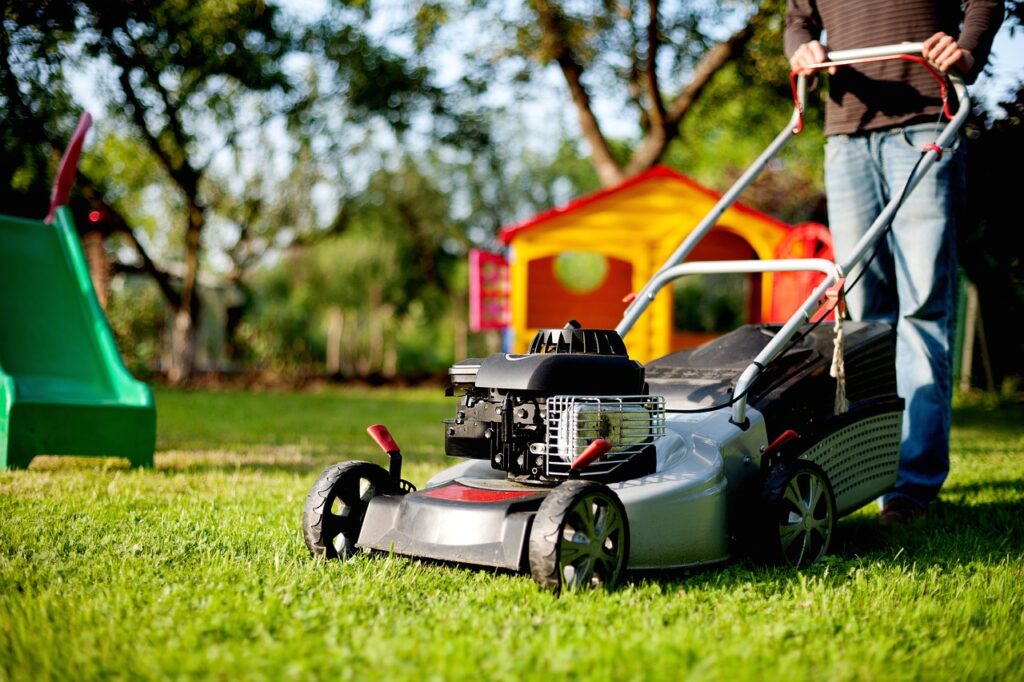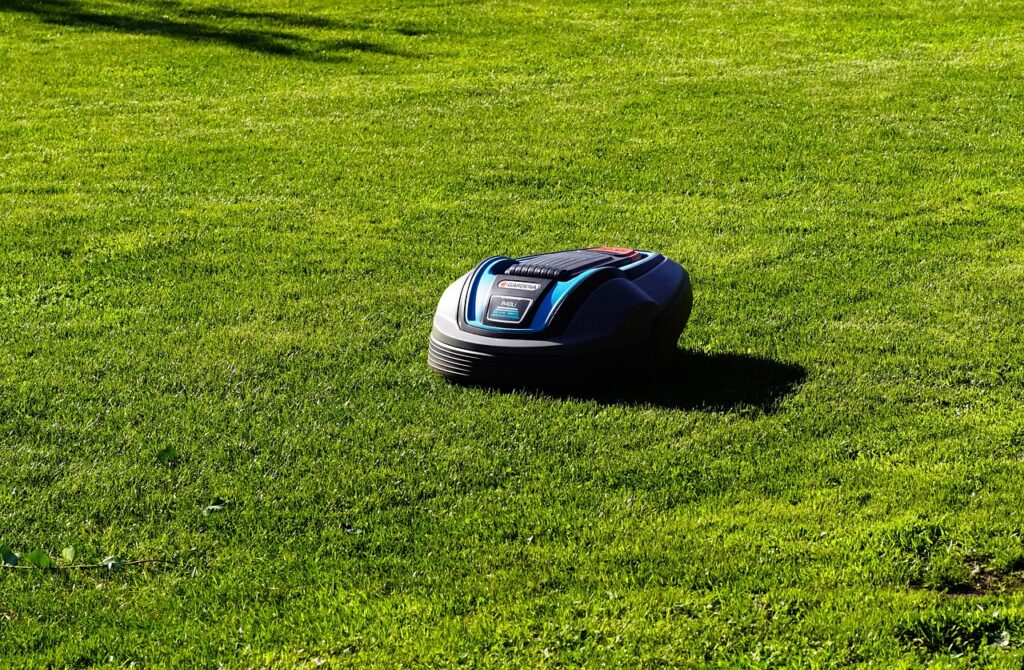Robotic lawn mowers offer several advantages over traditional mowers, with convenience and time-saving being the key benefits. These mowers are designed to take the work out of lawn maintenance, allowing you to enjoy a well-kept lawn with minimal effort.
One major benefit of robotic mowers is that they reduce your exposure to heat and allergens compared to using a traditional mower. Other features that set robotic mowers apart include:
- Random Mowing Patterns: Unlike traditional mowers that create wheel ruts, robotic mowers mow in random patterns, preventing the formation of tracks and promoting healthier grass growth.
- Self-Charging: Robotic mowers automatically return to their charging station when the battery runs low, ensuring they’re always ready for the next mowing session.
- Quieter Operation: These mowers are much quieter than gas-powered models, and some can even mow at night without disturbing the neighborhood.
- Rain Resistance: Many robotic mowers can operate in light rain, and some models feature rain sensors that automatically return the mower to the charging station when it detects wet conditions.
- Healthier Grass: Robotic mowers trim small amounts of grass at a time, often less than an inch. This promotes better grass growth, reduces stress on the lawn, and helps protect against pests and diseases. The small clippings also act as a natural fertilizer.
- Compact Storage: Robotic mowers take up much less space than traditional mowers. During the mowing season, they can remain at their charging station, and at the end of the season, they require less storage space.
Despite these unique features, robotic mowers share some important similarities with conventional mowers:
- Battery-Powered: Like cordless electric mowers, robotic mowers run on rechargeable batteries, eliminating the need for extension cords, gasoline, engine oil, and reducing both noise and emissions.
- Low Maintenance: Robotic mowers require less maintenance than traditional mowers. Routine tasks generally include cleaning the mower and periodically replacing the blades.
- Versatility in Yard Sizes: Robotic mowers come in different sizes to handle various lawn sizes. Smaller models are ideal for lawns up to 1/4 or 1/2 acre, while larger models can manage up to 1 acre or more.
- Slope Capability: Many robotic mowers can handle sloped yards with inclines of up to 24 degrees, making them suitable for a variety of terrains.
In conclusion, robotic mowers provide an efficient, low-maintenance solution for keeping your lawn in top shape with minimal effort. Whether you have a small or large lawn, or even a sloped yard, there’s a robotic mower that can meet your needs.
Additional Features and Benefits of Robotic Lawn Mowers
When choosing a robotic lawn mower, there are several advanced features that can enhance convenience and performance:
- No Gasoline or Engine Oil Required: Robotic mowers run on rechargeable batteries, eliminating the need for gasoline or engine oil, making them more eco-friendly and easier to maintain.
- App Integration: With app compatibility, you can manage and monitor your robotic mower from anywhere, adjusting settings or checking the mowing schedule directly from your mobile device.
- Adaptive Mowing Schedules: Advanced models can automatically adjust their mowing patterns and create a customized schedule based on the specific needs of your lawn, ensuring optimal maintenance and grass health.
- Interchangeable Batteries: In some cases, the batteries in robotic mowers can be used with other lawn care equipment, adding extra value and versatility to your outdoor tools.
These features make robotic mowers even more convenient, efficient, and adaptable to modern lifestyles, providing smarter solutions for lawn care.
How to Maintain Your Robotic Lawn Mower
Just like traditional lawn mowers, robotic mowers require regular maintenance to ensure optimal performance and longevity. While the maintenance process is straightforward, keeping up with it will help prevent wear and tear. Failing to maintain your robotic mower can result in:
- Dull or ineffective blades
- Dirty wheels, reducing grip and slowing the mower’s movement
- A clogged or dirty mowing unit, which can decrease efficiency and increase noise
- Weakened sensors, affecting safety features
- Dirt buildup on charging contacts, leading to longer charge times and more frequent recharging
Maintaining your robotic mower is simple when you follow the care guidelines for your specific model. Here are some key maintenance tasks:
- Keep the app and firmware updated: Regular updates help improve performance and add new features.
- Replace the blades regularly: Dull blades can reduce cutting efficiency and strain the motor.
- Clean the wheels: Use a brush or damp cloth to remove debris and keep the wheels moving smoothly.
- Clean the sensors: Wipe the sensors with a damp cloth to ensure they work effectively and safely.
- Clean the charging contacts: Wipe the charging terminals with a damp cloth and ensure they are dry before use to prevent charging issues.
- Check for corrosion: Inspect the mower for any signs of rust or wear, particularly on metal parts.
- Store the mower properly: During winter or off-seasons, store the mower and its battery in a dry, cool place to prevent damage.
By following these simple maintenance steps, you can keep your robotic mower in top condition and ensure it continues to deliver reliable performance season after season.
How to Choose the Best Robotic Lawn Mower
When selecting a robotic lawn mower, several key factors should guide your decision. Consider the following elements to ensure you pick the right mower for your needs:
1. Lawn Size
The size of your lawn plays a crucial role in determining the right mower. For smaller lawns, a less powerful model with a shorter battery life may suffice. However, for larger lawns, you’ll need a more powerful mower with a longer battery life to handle the increased area efficiently.
2. Lawn Complexity
The layout and obstacles in your yard also influence your choice. Robotic mowers can navigate around obstacles, but some are better suited for complex lawns than others. If your yard is simple and flat, the mower can easily move back and forth. However, if your lawn is irregularly shaped or filled with trees, bushes, and other obstacles, you’ll need a model with more advanced sensors and mapping capabilities to ensure it can efficiently navigate and cover the entire area.
3. Cost
Robotic lawn mowers tend to be more expensive than traditional push mowers, often costing two to three times as much, depending on their size, features, and performance. Prices can range from a few hundred to over a thousand dollars. Before making a purchase, it’s wise to list the features you truly need and compare models to ensure you get the best value for your budget.
By taking these factors into account, you can select the robotic lawn mower that best fits your lawn’s size, complexity, and your own desired level of control and convenience.
Relate post: Robotic Lawn Mower vs. Traditional Human-Powered Mower


